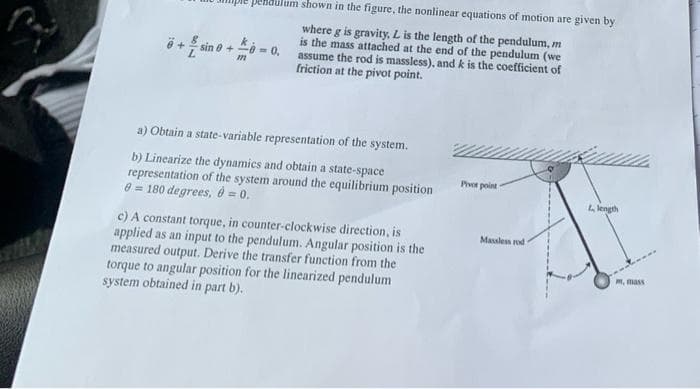a) Obtain a state-variable representation of the system. b) Linearize the dynamics and obtain a state-space representation of the system around the equilibrium position 0 = 180 degrees, = 0. Pvor point length c) A constant torque, in counter-clockwise direction, is applied as an input to the pendulum. Angular position is the measured output. Derive the transfer function from the torque to angular position for the linearized pendulum system obtained in part b). Massles rod M, mass
a) Obtain a state-variable representation of the system. b) Linearize the dynamics and obtain a state-space representation of the system around the equilibrium position 0 = 180 degrees, = 0. Pvor point length c) A constant torque, in counter-clockwise direction, is applied as an input to the pendulum. Angular position is the measured output. Derive the transfer function from the torque to angular position for the linearized pendulum system obtained in part b). Massles rod M, mass
Elements Of Electromagnetics
7th Edition
ISBN:9780190698614
Author:Sadiku, Matthew N. O.
Publisher:Sadiku, Matthew N. O.
ChapterMA: Math Assessment
Section: Chapter Questions
Problem 1.1MA
Related questions
Question

Transcribed Image Text:penaulum shown in the figure, the nonlinear equations of motion are given by
where g is gravity, L is the length of the pendulum, m
is the mass attached at the end of the pendulum (we
- 0.
assume the rod is massless), and k is the coefficient of
sin e
friction at the pivot point.
a) Obtain a state-variable representation of the system.
b) Linearize the dynamics and obtain a state-space
representation of the system around the equilibrium position
@ = 180 degrees, ở = 0.
Pvor point
Llength
c) A constant torque, in counter-clockwise direction, is
applied as an input to the pendulum. Angular position is the
measured output. Derive the transfer function from the
torque to angular position for the linearized pendulum
system obtained in part b).
Massles rod
m, mass
Expert Solution
This question has been solved!
Explore an expertly crafted, step-by-step solution for a thorough understanding of key concepts.
Step by step
Solved in 2 steps with 1 images

Knowledge Booster
Learn more about
Need a deep-dive on the concept behind this application? Look no further. Learn more about this topic, mechanical-engineering and related others by exploring similar questions and additional content below.Recommended textbooks for you

Elements Of Electromagnetics
Mechanical Engineering
ISBN:
9780190698614
Author:
Sadiku, Matthew N. O.
Publisher:
Oxford University Press

Mechanics of Materials (10th Edition)
Mechanical Engineering
ISBN:
9780134319650
Author:
Russell C. Hibbeler
Publisher:
PEARSON

Thermodynamics: An Engineering Approach
Mechanical Engineering
ISBN:
9781259822674
Author:
Yunus A. Cengel Dr., Michael A. Boles
Publisher:
McGraw-Hill Education

Elements Of Electromagnetics
Mechanical Engineering
ISBN:
9780190698614
Author:
Sadiku, Matthew N. O.
Publisher:
Oxford University Press

Mechanics of Materials (10th Edition)
Mechanical Engineering
ISBN:
9780134319650
Author:
Russell C. Hibbeler
Publisher:
PEARSON

Thermodynamics: An Engineering Approach
Mechanical Engineering
ISBN:
9781259822674
Author:
Yunus A. Cengel Dr., Michael A. Boles
Publisher:
McGraw-Hill Education

Control Systems Engineering
Mechanical Engineering
ISBN:
9781118170519
Author:
Norman S. Nise
Publisher:
WILEY

Mechanics of Materials (MindTap Course List)
Mechanical Engineering
ISBN:
9781337093347
Author:
Barry J. Goodno, James M. Gere
Publisher:
Cengage Learning

Engineering Mechanics: Statics
Mechanical Engineering
ISBN:
9781118807330
Author:
James L. Meriam, L. G. Kraige, J. N. Bolton
Publisher:
WILEY